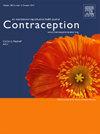急诊科的堕胎护理:全国急诊科医生观点调查
IF 2.8
2区 医学
Q1 OBSTETRICS & GYNECOLOGY
引用次数: 0
摘要
目标急诊科是诊断意外怀孕的常见场所,尤其是对那些医疗条件有限的患者而言。可以在急诊环境中提供生殖健康服务,以扩大对这一人群的护理,这在多布斯诉杰克逊妇女健康组织案之后尤为重要。本研究旨在评估急诊科医生在多布斯案前后对妊娠选择咨询、转诊以及在急诊科提供人工流产服务的现有知识、态度和实践。我们使用 Kruskall-Wallis 检验来评估限制堕胎州和允许堕胎州之间的差异,并使用卡方检验来比较两组之间的比例。结果 共有 252 名急诊科医生完成了调查,其中 218 人(86.5%)来自允许堕胎的州,30 人(11.9%)来自限制堕胎的州。大多数医生(178 人,占 70.6%)支持在法律允许的情况下在急诊科提供人工流产服务,但只有约半数医生(131 人,占 52.0%)表示曾开过药物流产药方。只有 27 人(10.7%)表示拥有足够的知识或接受过足够的培训,可以独立开具药物流产处方。结论急诊科可以也应该提供人工流产服务,尤其是在多布斯案判决后,为了扩大生殖医疗服务的可及性。虽然大多数急诊科医生都支持在这种情况下提供人工流产护理,但由于缺乏知识、缺乏培训以及法律/机构限制等多种因素,他们并不经常提供人工流产护理。本文章由计算机程序翻译,如有差异,请以英文原文为准。
ABORTION CARE IN THE EMERGENCY DEPARTMENT: A NATIONAL SURVEY OF EMERGENCY MEDICINE PHYSICIANS’ PERSPECTIVES
Objectives
The emergency department is a common setting of unintended pregnancy diagnoses, particularly for patients with limited access to healthcare. Reproductive health services can be provided in the emergency setting to expand care for this population, especially important post Dobbs v Jackson Women’s Health Organization. This study seeks to assess emergency medicine physicians’ current knowledge, attitudes, and practices, before and after Dobbs, related to pregnancy options counseling, referrals, and provision of induced abortion in the emergency department.
Methods
We surveyed a sample of emergency medicine physicians at a national meeting regarding knowledge, attitudes, and practices related to reproductive healthcare delivery. Kruskall-Wallis tests were used to evaluate differences between abortion restrictive and permissive states and chi-squared tests were used to compare proportions between the two groups. Thematic analysis was used to review qualitative responses.
Results
A total of 252 emergency medicine physicians completed the survey, 218 (86.5%) from abortion permissive and 30 (11.9%) from abortion restrictive states. Most (n=178, 70.6%) supported abortion provision in the emergency department if legally allowed although only about half (n=131, 52.0%) report ever prescribing medication abortion pills. Only 27 (10.7%) report possessing enough knowledge or having received adequate training to independently prescribe medication abortion.
Conclusions
Abortion can and should be provided in the emergency department, especially in an attempt to expand access to reproductive healthcare after the Dobbs decision. While most emergency medicine physicians support the provision of abortion care this setting, they do not routinely provide it due to a variety of factors including lack of knowledge, lack of training, and legal/institutional restrictions.
求助全文
通过发布文献求助,成功后即可免费获取论文全文。
去求助
来源期刊

Contraception
医学-妇产科学
CiteScore
4.70
自引率
17.20%
发文量
211
审稿时长
69 days
期刊介绍:
Contraception has an open access mirror journal Contraception: X, sharing the same aims and scope, editorial team, submission system and rigorous peer review.
The journal Contraception wishes to advance reproductive health through the rapid publication of the best and most interesting new scholarship regarding contraception and related fields such as abortion. The journal welcomes manuscripts from investigators working in the laboratory, clinical and social sciences, as well as public health and health professions education.
 求助内容:
求助内容: 应助结果提醒方式:
应助结果提醒方式:


